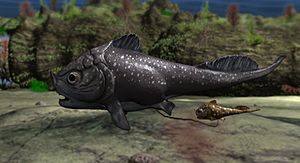Materpiscis facts for kids
Quick facts for kids MaterpiscisTemporal range: late Devonian
|
|
|---|---|
 |
|
| A female Materpiscis giving live birth | |
| Scientific classification | |
| Kingdom: | |
| Phylum: | |
| Class: | |
| Order: |
Ptyctodontida
|
| Family: |
Ptyctodontidae
|
| Genus: |
Materpiscis
|
| Binomial name | |
| M. attenboroughi Long et al 2008
|
|
Materpiscis (say "Mah-ter-PIS-sis") means "mother fish" in Latin. It's a very old type of armored fish called a placoderm. This amazing fish lived about 380 million years ago during the late Devonian period. Scientists found a fossil of Materpiscis that showed something incredible: a baby fish still inside its mother! This discovery proved that Materpiscis is the oldest known animal with a backbone that gave birth to live young. This way of having babies is called viviparity.
Contents
What is Materpiscis?
Materpiscis was a type of placoderm. These were ancient fish that had bony armor covering their heads and parts of their bodies. They are now extinct, meaning they no longer exist on Earth. Materpiscis belonged to a group called ptyctodontids.
This fish lived during the Devonian period. This time is often called the "Age of Fish" because many different kinds of fish lived then. Materpiscis swam in the ancient seas of what is now Australia.
An Amazing Discovery: Live Birth!
The most exciting thing about Materpiscis is how it reproduced. Scientists found a fossil that clearly showed an embryo (a developing baby) inside the mother fish. This baby fish was connected to its mother by an umbilical cord. This is just like how some modern animals, including humans, are born!
This discovery was very important. It showed that viviparity (giving birth to live young) is a very old way of having babies. Before this, scientists thought live birth evolved much later in animals with backbones. Many modern fish, especially some types of sharks, also give birth to live young.
Where Was Materpiscis Found?
The special fossil of Materpiscis was found in the Kimberley area of northern Western Australia. This region is famous for its amazing fossils. The fossils come from a place called the Gogo Formation.
These fossils are unique because they are preserved inside hard rocks called limestone nodules. To get the fossils out, scientists use a weak acid called acetic acid. This acid slowly dissolves the limestone without harming the delicate fossil inside. This method helps keep the fossils in great shape, often in 3D, which is rare for such old remains.
Named After a Famous Explorer
The full name of the species is Materpiscis attenboroughi. It was named to honor David Attenborough. He is a very famous naturalist and filmmaker.
David Attenborough first brought attention to the important Gogo fish fossil sites. He did this in his 1979 TV series called Life on Earth. His work helped scientists understand how special these fossil discoveries were.
Images for kids
See also
 In Spanish: Materpiscis para niños
In Spanish: Materpiscis para niños


